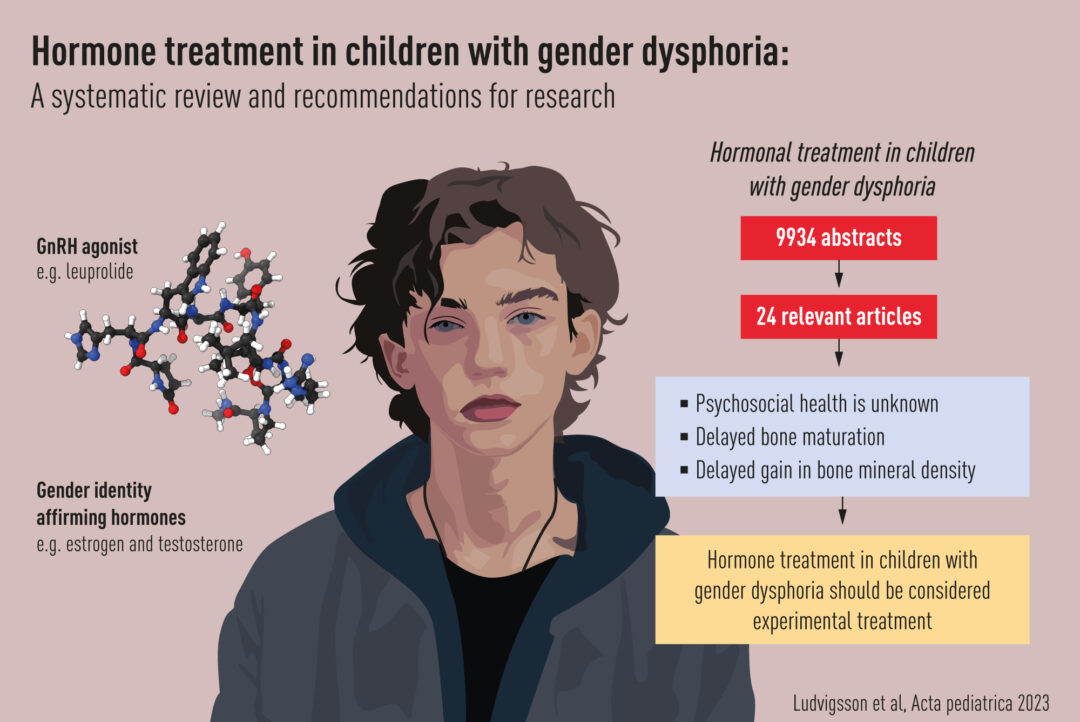Hormone treatment is one of the interventions that has been used to address so-called ‘gender dysphoria’ in children, but there is a need for more evidence-based guidance on the safety and efficacy of such treatments. A recent systematic review by Ludvigsson et al. (2023) aimed to evaluate the current evidence on hormone treatment for children with gender dysphoria and provide recommendations for future research.
A systematic review of hormone treatment for children with gender dysphoria and recommendations for research
Jonas F. Ludvigsson, Jan Adolfsson, Malin Höistad, Per-Anders Rydelius, Berit Kriström, Mikael Landén
https://onlinelibrary.wiley.com/doi/epdf/10.1111/apa.16791
CONCLUSION
This systematic review of almost 10,000 screened abstracts suggests that long-term effects of hormone therapy on psychosocial and somatic health are unknown, except that GnRHa treatment seems to delay bone maturation and gain in bone mineral density.
Accessible Synopsis
The authors conducted a comprehensive search of several databases to identify studies that evaluated the use of gonadotropin-releasing hormone analogs (GnRHa) or cross-sex hormones (CSH) in children up to 18 years of age with gender dysphoria. They identified 10 studies that evaluated the use of GnRHa, which is typically used to suppress puberty, giving children time to explore their gender identity and make informed decisions about future treatment options. They also identified 10 studies that evaluated the use of CSH, which involve the administration of hormones that are typically associated with the opposite sex.
The authors found that the quality of evidence for the use of both GnRHa and CSH was moderate to high, indicating that the findings are likely to be reliable. However, they also noted that there is a lack of long-term evidence for the psychosocial effects of both types of hormone treatment.
Short-term gain for long-term pain
With regards to GnRHa treatment, the studies showed that it was effective in reducing gender dysphoria symptoms and improving psychological well-being in children with gender dysphoria in the short-term. Specifically, the studies found that GnRHa reduced symptoms of depression, anxiety, and social withdrawal. Additionally, GnRHa treatment was associated with improved body image, self-esteem, and overall quality of life for children with gender dysphoria. However, the authors noted that the long-term safety and efficacy of GnRHa treatment in children with gender dysphoria is still uncertain, particularly in terms of bone health and fertility.
Regarding CSH treatment, the studies showed that it was also effective in reducing gender dysphoria symptoms and improving psychological well-being in children with gender dysphoria in the short-term. Specifically, the studies found that CSH treatment led to improved mental health outcomes, including reductions in symptoms of anxiety and depression. However, the authors noted that there is a lack of long-term evidence for the psychosocial effects of CSH treatment, particularly in terms of its impact on cognitive function, bone health, cardiovascular health, and the risk of cancer.
Furthermore, the studies showed that both GnRHa and CSH treatment increased the likelihood of subsequent gender-affirming surgeries in children with transgender ideation. The authors noted that surgery is a complex and irreversible intervention that should be approached with caution. They emphasized the need for further research to evaluate the long-term safety and efficacy of both GnRHa and CSH treatment, particularly in terms of their potential negative effects on bone health, fertility, cognitive function, cardiovascular health, and cancer.
Overall, Ludvigsson et al.’s (2023) systematic review highlights the need for more evidence-based guidance on the use of hormone treatment for children with gender dysphoria. While the studies reviewed by the authors suggest that both GnRHa and CSH treatment are effective options for reducing gender dysphoria symptoms and improving psychological well-being in children with gender dysphoria in the short-term, the lack of long-term evidence underscores the need for caution

